CASE BASED/SOURCE-BASED INTEGRATED QUESTIONS from U-LIKE PHYSICS Chapter 20 MOVING CHARGES AND MAGNETISM for Class 12
| Class 12 | PHYSICS |
| Chapter | MOVING CHARGES AND MAGNETISM |
| U-LIKE PHYSICS | CASE BASED/SOURCE-BASED INTEGRATED QUESTIONS |
| Medium | English |
| Academic Year | 2023-2024 |
Question 1
When we consider a point charge q moving with a velocity →v at a given time in presence of magnetic field →B, the charged particle experiences a magnetic force →Fm=q[→v×→B]. The force was first given by H.A. Lorentz and is called the Lorentz magnetic force. The force depends on q, →vand→B and involves a vector product of →vand→B. The force acts in a side ways direction perpendicular to both the velocity and magnetic field and the direction is given by right hand thumb rule for vector product. Obviously force on a negative charge is opposite to that on a positive charge.
A charged particle is placed at rest at a point P whose coordinates are (2,3,0) and a magnetic field →B=5×10−3ˆk is present here. What is the magnetic force experienced by the charge ? View SolutionQuestion 2
When we consider a point charge q moving with a velocity →v at a given time in presence of magnetic field →B, the charged particle experiences a magnetic force →Fm=q[→v×→B]. The force was first given by H.A. Lorentz and is called the Lorentz magnetic force. The force depends on q, →vand→B and involves a vector product of →vand→B. The force acts in a side ways direction perpendicular to both the velocity and magnetic field and the direction is given by right hand thumb rule for vector product. Obviously force on a negative charge is opposite to that on a positive charge.
An electron enters a given region moving with an initial velocity →v=12.5ˆims−1 where a unifomr magnetic field →B=B0ˆj is also applied. What is the direction of force experienced by electron due to the magnetic field? View SolutionQuestion 3
When we consider a point charge q moving with a velocity →v at a given time in presence of magnetic field →B, the charged particle experiences a magnetic force →Fm=q[→v×→B]. The force was first given by H.A. Lorentz and is called the Lorentz magnetic force. The force depends on q, →vand→B and involves a vector product of →vand→B. The force acts in a side ways direction perpendicular to both the velocity and magnetic field and the direction is given by right hand thumb rule for vector product. Obviously force on a negative charge is opposite to that on a positive charge.
Define SI unit of magnetic field on the basis of Lorentz force. View SolutionQuestion 4
When we consider a point charge q moving with a velocity →v at a given time in presence of magnetic field →B, the charged particle experiences a magnetic force →Fm=q[→v×→B]. The force was first given by H.A. Lorentz and is called the Lorentz magnetic force. The force depends on q, →vand→B and involves a vector product of →vand→B. The force acts in a side ways direction perpendicular to both the velocity and magnetic field and the direction is given by right hand thumb rule for vector product. Obviously force on a negative charge is opposite to that on a positive charge.
Under what condition does a moving charge experience minimum force due to a magnetic field present there? View SolutionQuestion 5
When we consider a point charge q moving with a velocity →v at a given time in presence of magnetic field →B, the charged particle experiences a magnetic force →Fm=q[→v×→B]. The force was first given by H.A. Lorentz and is called the Lorentz magnetic force. The force depends on q, →vand→B and involves a vector product of →vand→B. The force acts in a side ways direction perpendicular to both the velocity and magnetic field and the direction is given by right hand thumb rule for vector product. Obviously force on a negative charge is opposite to that on a positive charge.
When will a moving charge experience maximum force due to a magnetic field? View SolutionQuestion 6
A current circular conducting loop exerts a magnetic field both inside and outside it. The magnetic field at the cetre of a current loop of radius 'R' and carrying a current I is given as :
B=μ0I2R
The magnetic field lines due to a circular current loop form closed loops. The direction of the magnetic field is given by the right hand thumb rule, which states that if one curls the palm of his right hand around the current loop with the fingers pointing in the direction of the current, the right hand thumb will give the direction of the magnetic field. From this law it is clear that the direction of magnetic field →B is always perpendicular to the direction of flow of current or perpendicular to the plane of circular current loop.
Does a charge at rest produes a magnetic field around it? View SolutionQuestion 7
A current circular conducting loop exerts a magnetic field both inside and outside it. The magnetic field at the cetre of a current loop of radius 'R' and carrying a current I is given as :
B=μ0I2R
The magnetic field lines due to a circular current loop form closed loops. The direction of the magnetic field is given by the right hand thumb rule, which states that if one curls the palm of his right hand around the current loop with the fingers pointing in the direction of the current, the right hand thumb will give the direction of the magnetic field. From this law it is clear that the direction of magnetic field →B is always perpendicular to the direction of flow of current or perpendicular to the plane of circular current loop.
Draw the magnetic field lines due to a circular current loop placed in a horizontal plane. View SolutionQuestion 8
A current circular conducting loop exerts a magnetic field both inside and outside it. The magnetic field at the cetre of a current loop of radius 'R' and carrying a current I is given as :
B=μ0I2R
The magnetic field lines due to a circular current loop form closed loops. The direction of the magnetic field is given by the right hand thumb rule, which states that if one curls the palm of his right hand around the current loop with the fingers pointing in the direction of the current, the right hand thumb will give the direction of the magnetic field. From this law it is clear that the direction of magnetic field →B is always perpendicular to the direction of flow of current or perpendicular to the plane of circular current loop.
Draw the magnetic field lines due to a circular current loop placed in a horizontal plane.
An enamelled copper wire of length L is bent in the form of a circular loop and a curretn I is passed through it so that a magnetic field B is get up at its centre. Now the same wire is bent in the form of a circular coil having N turns and same current I is passed through it. What is the magnetic field develop at the centre of this coil? View SolutionQuestion 9
A current circular conducting loop exerts a magnetic field both inside and outside it. The magnetic field at the cetre of a current loop of radius 'R' and carrying a current I is given as :
B=μ0I2R

The magnetic field lines due to a circular current loop form closed loops. The direction of the magnetic field is given by the right hand thumb rule, which states that if one curls the palm of his right hand around the current loop with the fingers pointing in the direction of the current, the right hand thumb will give the direction of the magnetic field. From this law it is clear that the direction of magnetic field →B is always perpendicular to the direction of flow of current or perpendicular to the plane of circular current loop.
Determine the magnetic field at the centre point O due to two concentric semicircular loops of radii R1andR2 carrying a current I, when the loops of radii R1andR2 carrying a current I, when the loops are arranged as shown in Fig.View SolutionQuestion 10
A current circular conducting loop exerts a magnetic field both inside and outside it. The magnetic field at the cetre of a current loop of radius 'R' and carrying a current I is given as :
B=μ0I2R
The magnetic field lines due to a circular current loop form closed loops. The direction of the magnetic field is given by the right hand thumb rule, which states that if one curls the palm of his right hand around the current loop with the fingers pointing in the direction of the current, the right hand thumb will give the direction of the magnetic field. From this law it is clear that the direction of magnetic field →B is always perpendicular to the direction of flow of current or perpendicular to the plane of circular current loop.
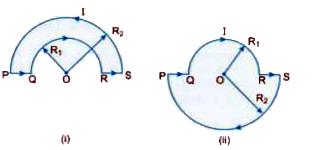
How is the magnetic field at O modified when the two loops are rearranged as shown in Fig. View SolutionQuestion 11
A moving coil galvanometer is a sensitive device which can be used as a detector to check if a curretn is flowing in a circuit. A galvanometer works on the principle that a current carrying coil placed in a radial magnetic field experiences a deflecting torque whose magnitudes is directly proportional to the electric current passing through it. The deflection ϕ is indicated by a pointer and is give as ϕ=NABk⋅I.
A galvonometer can be used to measure electric current flowing througha circuit direcly in ampere and its submultiples. For this purpose we join a small resistance 'rs' in parallel to the galvonometer. Such a shunted galvonometer is called an ammeter. If a galvanomter, having a resistance RG, givens full scale deflection for a current Ig and we want to measure a current ranging from 0−IgA, then the value of shunt resistance will be
rs=RG⋅IgI−Ig

Why do we use a radial magnetic field in a moving coil galvonometer? View SolutionQuestion 12
A moving coil galvanometer is a sensitive device which can be used as a detector to check if a curretn is flowing in a circuit. A galvanometer works on the principle that a current carrying coil placed in a radial magnetic field experiences a deflecting torque whose magnitudes is directly proportional to the electric current passing through it. The deflection ϕ is indicated by a pointer and is give as ϕ=NABk⋅I.
A galvonometer can be used to measure electric current flowing througha circuit direcly in ampere and its submultiples. For this purpose we join a small resistance 'rs' in parallel to the galvonometer. Such a shunted galvonometer is called an ammeter. If a galvanomter, having a resistance RG, givens full scale deflection for a current Ig and we want to measure a current ranging from 0−IgA, then the value of shunt resistance will be
rs=RG⋅IgI−Ig
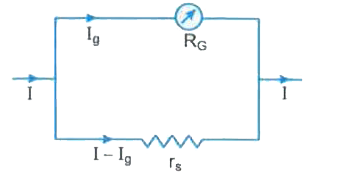
How is a radial magnetic field obtained? View SolutionQuestion 13
A moving coil galvanometer is a sensitive device which can be used as a detector to check if a curretn is flowing in a circuit. A galvanometer works on the principle that a current carrying coil placed in a radial magnetic field experiences a deflecting torque whose magnitudes is directly proportional to the electric current passing through it. The deflection ϕ is indicated by a pointer and is give as ϕ=NABk⋅I.
A galvonometer can be used to measure electric current flowing througha circuit direcly in ampere and its submultiples. For this purpose we join a small resistance 'rs' in parallel to the galvonometer. Such a shunted galvonometer is called an ammeter. If a galvanomter, having a resistance RG, givens full scale deflection for a current Ig and we want to measure a current ranging from 0−IgA, then the value of shunt resistance will be
rs=RG⋅IgI−Ig
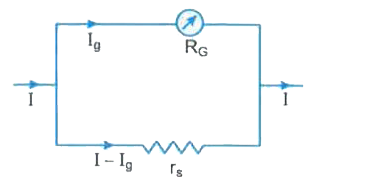
There is a moving coil galvonometer in which there are 30 divisions on either side of central zero mark. It gives full scale deflection for a current of 600μA. What is its current sensitivity ? View SolutionQuestion 14
A moving coil galvanometer is a sensitive device which can be used as a detector to check if a curretn is flowing in a circuit. A galvanometer works on the principle that a current carrying coil placed in a radial magnetic field experiences a deflecting torque whose magnitudes is directly proportional to the electric current passing through it. The deflection ϕ is indicated by a pointer and is give as ϕ=NABk⋅I.
A galvonometer can be used to measure electric current flowing througha circuit direcly in ampere and its submultiples. For this purpose we join a small resistance 'rs' in parallel to the galvonometer. Such a shunted galvonometer is called an ammeter. If a galvanomter, having a resistance RG, givens full scale deflection for a current Ig and we want to measure a current ranging from 0−IgA, then the value of shunt resistance will be
rs=RG⋅IgI−Ig
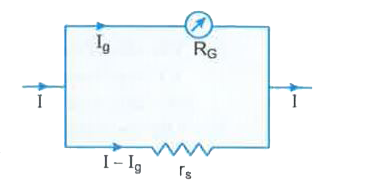
If you want to measure a current ranging 0 - 1.5 A using the above galvonometer. What shunt resistance should be joined with it ? Resistance of galvanometer coil is 300Ω. View SolutionQuestion 15
A moving coil galvanometer is a sensitive device which can be used as a detector to check if a curretn is flowing in a circuit. A galvanometer works on the principle that a current carrying coil placed in a radial magnetic field experiences a deflecting torque whose magnitudes is directly proportional to the electric current passing through it. The deflection ϕ is indicated by a pointer and is give as ϕ=NABk⋅I.
A galvonometer can be used to measure electric current flowing througha circuit direcly in ampere and its submultiples. For this purpose we join a small resistance 'rs' in parallel to the galvonometer. Such a shunted galvonometer is called an ammeter. If a galvanomter, having a resistance RG, givens full scale deflection for a current Ig and we want to measure a current ranging from 0−IgA, then the value of shunt resistance will be
rs=RG⋅IgI−Ig
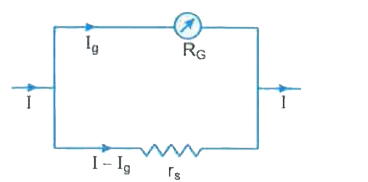
What is the net resistance of shunted galvanomter? View SolutionQuestion 16
A few countires are using powerful electromagnets to develop high speed trains, called maglev trains (also known as bullet trains). Maglev is short for 'magnetic levitation', which means that these trains will float over a guil way using the basic principles of magnets to replace the old steel wheel and track trains.
The big difference between a maglev train and a conventional train is that maglev trains do not have an engine. The engine for maglev trains is rather inconspicuous as instead of fossil fuels it uses magnetic field. The magnetised coil running along the track, called the guideway, repels the large magents on the trains's under carriage allowing the train to levitate between 1 to 10 cm above the guideway . This is called electrodyanmic suspension (EDS). Once the train is levitated, power is supplied to the coils within the guideway walls to create a unique system of magnetic fields that pull and push the train along the guideway. The electric current supplied to the coils in the guideway wall is constantly alternating to change the polarity of the magnetised coils. This change in polarity causes the magnetic field in fornt of the train to pull the vehicle forward, while the magnetic field behind the train adds more forward thrust.
Maglev trains float on a cushion of air eliminating friction. This lack of friction and the train's aerodynamic design allows these trains to reach unprecedented group transportation speed of 400kmh−1 or even more.
The force which makes maglev move is View SolutionQuestion 17
A few countires are using powerful electromagnets to develop high speed trains, called maglev trains (also known as bullet trains). Maglev is short for 'magnetic levitation', which means that these trains will float over a guil way using the basic principles of magnets to replace the old steel wheel and track trains.
The big difference between a maglev train and a conventional train is that maglev trains do not have an engine. The engine for maglev trains is rather inconspicuous as instead of fossil fuels it uses magnetic field. The magnetised coil running along the track, called the guideway, repels the large magents on the trains's under carriage allowing the train to levitate between 1 to 10 cm above the guideway . This is called electrodyanmic suspension (EDS). Once the train is levitated, power is supplied to the coils within the guideway walls to create a unique system of magnetic fields that pull and push the train along the guideway. The electric current supplied to the coils in the guideway wall is constantly alternating to change the polarity of the magnetised coils. This change in polarity causes the magnetic field in fornt of the train to pull the vehicle forward, while the magnetic field behind the train adds more forward thrust.
Maglev trains float on a cushion of air eliminating friction. This lack of friction and the train's aerodynamic design allows these trains to reach unprecedented group transportation speed of 400kmh−1 or even more.
The disadvantage of maglev trains is View SolutionQuestion 18
A few countires are using powerful electromagnets to develop high speed trains, called maglev trains (also known as bullet trains). Maglev is short for 'magnetic levitation', which means that these trains will float over a guil way using the basic principles of magnets to replace the old steel wheel and track trains.
The big difference between a maglev train and a conventional train is that maglev trains do not have an engine. The engine for maglev trains is rather inconspicuous as instead of fossil fuels it uses magnetic field. The magnetised coil running along the track, called the guideway, repels the large magents on the trains's under carriage allowing the train to levitate between 1 to 10 cm above the guideway . This is called electrodyanmic suspension (EDS). Once the train is levitated, power is supplied to the coils within the guideway walls to create a unique system of magnetic fields that pull and push the train along the guideway. The electric current supplied to the coils in the guideway wall is constantly alternating to change the polarity of the magnetised coils. This change in polarity causes the magnetic field in fornt of the train to pull the vehicle forward, while the magnetic field behind the train adds more forward thrust.
Maglev trains float on a cushion of air eliminating friction. This lack of friction and the train's aerodynamic design allows these trains to reach unprecedented group transportation speed of 400kmh−1 or even more.
The levitation of the train is due to View Solution
All Exercises from U-LIKE PHYSICS Class 12 PHYSICS MOVING CHARGES AND MAGNETISM
- ADDITIONAL EXERCISES
- ASSERTION-REASON TYPE QUESTIONS
- CASE BASED/SOURCE-BASED INTEGRATED QUESTIONS
- FILL IN THE BLANKS
- LONG ANSWER QUESTIONS-I
- LONG ANSWER QUESTIONS-II
- MULTIPLE CHOICE QUESTIONS
- N.C.E.R.T. TEXTBOOK EXERCISES
- SELF ASSESSMENT TEST (SECTION A) (FILL IN THE BLANKS)
- SELF ASSESSMENT TEST (SECTION A) (MULTIPLE CHOICE QUESTIONS)
- SELF ASSESSMENT TEST (SECTION B)
- SELF ASSESSMENT TEST (SECTION C)
- SELF ASSESSMENT TEST (SECTION D)
- SHORT ANSWER QUESTIONS
- TRUE OR FALSE
- VERY SHORT ANSWER QUESTIONS